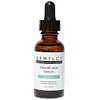What's inside
What's inside
 Key Ingredients
Key Ingredients

 Benefits
Benefits

 Concerns
Concerns

No concerns
 Ingredients Side-by-side
Ingredients Side-by-side

Water
Skin ConditioningGlycerin
HumectantNiacinamide
SmoothingSodium Chondroitin Sulfate
Skin ConditioningMethylglucoside Phosphate
Skin ConditioningCopper Lysinate/Prolinate
Skin ConditioningGlycosaminoglycans
EmollientBambusa Vulgaris Leaf/Stem Extract
HumectantPisum Sativum Extract
Skin ConditioningGlucosamine Hcl
Sodium Hyaluronate
HumectantPanthenol
Skin ConditioningPhenoxyethanol
PreservativeEthylhexylglycerin
Skin ConditioningPolysorbate 20
EmulsifyingDisodium EDTA
Water, Glycerin, Niacinamide, Sodium Chondroitin Sulfate, Methylglucoside Phosphate, Copper Lysinate/Prolinate, Glycosaminoglycans, Bambusa Vulgaris Leaf/Stem Extract, Pisum Sativum Extract, Glucosamine Hcl, Sodium Hyaluronate, Panthenol, Phenoxyethanol, Ethylhexylglycerin, Polysorbate 20, Disodium EDTA
Water
Skin ConditioningDiisopropyl Adipate
EmollientDicaprylyl Carbonate
EmollientGlycerin
HumectantSqualane
EmollientCaprylic/Capric Triglyceride
MaskingPolyglyceryl-2 Dipolyhydroxystearate
Skin ConditioningIsoamyl Laurate
EmollientLactococcus Ferment Lysate
Skin ConditioningSimmondsia Chinensis Seed Oil
EmollientTriethylhexanoin
MaskingStearalkonium Hectorite
Gel FormingBakuchiol
AntimicrobialStevia Rebaudiana Leaf/Stem Extract
MaskingLycium Barbarum Fruit Extract
AstringentDaucus Carota Sativa Root Extract
Skin ConditioningBeta-Carotene
Skin ConditioningLactic Acid
BufferingGluconolactone
Skin ConditioningLactobacillus
Skin ConditioningPolyglyceryl-3 Diisostearate
EmulsifyingPolyglyceryl-3 Polyricinoleate
EmulsifyingMagnesium Sulfate
Squalene
EmollientTocopheryl Acetate
AntioxidantTocopherol
AntioxidantAlpha-Glucan Oligosaccharide
CleansingPropanediol
SolventLecithin
EmollientPolymnia Sonchifolia Root Juice
Skin ConditioningSodium Phytate
Medicago Sativa Extract
TonicHydrogenated Phosphatidylcholine
EmulsifyingLysolecithin
EmulsifyingMaltodextrin
AbsorbentGlycine Soja Oil
EmollientCalcium Gluconate
HumectantSodium Benzoate
MaskingEthylhexylglycerin
Skin ConditioningCaprylyl Glycol
EmollientSodium Chloride
MaskingCitric Acid
BufferingBeta-Sitosterol
Emulsion StabilisingPhenoxyethanol
PreservativePotassium Sorbate
PreservativePhytic Acid
Water, Diisopropyl Adipate, Dicaprylyl Carbonate, Glycerin, Squalane, Caprylic/Capric Triglyceride, Polyglyceryl-2 Dipolyhydroxystearate, Isoamyl Laurate, Lactococcus Ferment Lysate, Simmondsia Chinensis Seed Oil, Triethylhexanoin, Stearalkonium Hectorite, Bakuchiol, Stevia Rebaudiana Leaf/Stem Extract, Lycium Barbarum Fruit Extract, Daucus Carota Sativa Root Extract, Beta-Carotene, Lactic Acid, Gluconolactone, Lactobacillus, Polyglyceryl-3 Diisostearate, Polyglyceryl-3 Polyricinoleate, Magnesium Sulfate, Squalene, Tocopheryl Acetate, Tocopherol, Alpha-Glucan Oligosaccharide, Propanediol, Lecithin, Polymnia Sonchifolia Root Juice, Sodium Phytate, Medicago Sativa Extract, Hydrogenated Phosphatidylcholine, Lysolecithin, Maltodextrin, Glycine Soja Oil, Calcium Gluconate, Sodium Benzoate, Ethylhexylglycerin, Caprylyl Glycol, Sodium Chloride, Citric Acid, Beta-Sitosterol, Phenoxyethanol, Potassium Sorbate, Phytic Acid
 Reviews
Reviews

Ingredients Explained
These ingredients are found in both products.
Ingredients higher up in an ingredient list are typically present in a larger amount.
Ethylhexylglycerin (we can't pronounce this either) is commonly used as a preservative and skin softener. It is derived from glyceryl.
You might see Ethylhexylglycerin often paired with other preservatives such as phenoxyethanol. Ethylhexylglycerin has been found to increase the effectiveness of these other preservatives.
Glycerin is already naturally found in your skin. It helps moisturize and protect your skin.
A study from 2016 found glycerin to be more effective as a humectant than AHAs and hyaluronic acid.
As a humectant, it helps the skin stay hydrated by pulling moisture to your skin. The low molecular weight of glycerin allows it to pull moisture into the deeper layers of your skin.
Hydrated skin improves your skin barrier; Your skin barrier helps protect against irritants and bacteria.
Glycerin has also been found to have antimicrobial and antiviral properties. Due to these properties, glycerin is often used in wound and burn treatments.
In cosmetics, glycerin is usually derived from plants such as soybean or palm. However, it can also be sourced from animals, such as tallow or animal fat.
This ingredient is organic, colorless, odorless, and non-toxic.
Glycerin is the name for this ingredient in American English. British English uses Glycerol/Glycerine.
Learn more about GlycerinPhenoxyethanol is a preservative that has germicide, antimicrobial, and aromatic properties. Studies show that phenoxyethanol can prevent microbial growth. By itself, it has a scent that is similar to that of a rose.
It's often used in formulations along with Caprylyl Glycol to preserve the shelf life of products.
Water. It's the most common cosmetic ingredient of all. You'll usually see it at the top of ingredient lists, meaning that it makes up the largest part of the product.
So why is it so popular? Water most often acts as a solvent - this means that it helps dissolve other ingredients into the formulation.
You'll also recognize water as that liquid we all need to stay alive. If you see this, drink a glass of water. Stay hydrated!
Learn more about Water